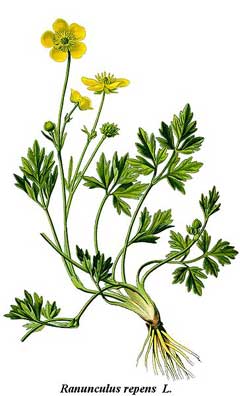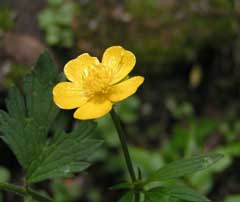 |
|
http://commons.wikimedia.org/wiki/File:Cleaned-Illustration_Ranunculus_repens.jpg |
 |
| http://commons.wikimedia.org/wiki/User:Sannse |
Translate this page:
Summary
Bloom Color: Yellow. Main Bloom Time: Early summer, Early fall, Late summer, Late spring, Mid summer. Form: Spreading or horizontal, Upright or erect.
Physical Characteristics

 Ranunculus repens is a PERENNIAL growing to 0.3 m (1ft) by 1 m (3ft 3in) at a fast rate.
Ranunculus repens is a PERENNIAL growing to 0.3 m (1ft) by 1 m (3ft 3in) at a fast rate.
It is not frost tender. It is in flower from May to August. The species is hermaphrodite (has both male and female organs) and is pollinated by Bees, flies, beetles.
Suitable for: light (sandy), medium (loamy) and heavy (clay) soils and can grow in heavy clay soil. Suitable pH: mildly acid, neutral and basic (mildly alkaline) soils. It can grow in semi-shade (light woodland) or no shade. It prefers moist soil.
UK Hardiness Map
US Hardiness Map
Synonyms
Plant Habitats
Woodland Garden Dappled Shade; Shady Edge; Meadow;
Edible Uses
Edible Parts: Leaves Root
Edible Uses:
Leaves - cooked and used as a pot-herb[2, 105]. A famine food, used when all else fails, and I would rather give it a miss even then[K]! See the notes above on toxicity. Root - must be dried beforehand and thoroughly cooked[118]. Personally, I would rather give this one a miss[K], see the notes above on toxicity.
References More on Edible Uses
Medicinal Uses
Plants For A Future can not take any responsibility for any adverse effects from the use of plants. Always seek advice from a professional before using a plant medicinally.
Analgesic Rubefacient
The entire plant is analgesic and rubefacient[257]. A poultice of the chewed leaves has been used in the treatment of sores, muscular aches and rheumatic pains[257]. Some caution is advised in the use of this plant, see the notes above on toxicity.
References More on Medicinal Uses
The Bookshop: Edible Plant Books
Our Latest books on Perennial Plants For Food Forests and Permaculture Gardens in paperback or digital formats.

Edible Tropical Plants
Food Forest Plants for Hotter Conditions: 250+ Plants For Tropical Food Forests & Permaculture Gardens.
More

Edible Temperate Plants
Plants for Your Food Forest: 500 Plants for Temperate Food Forests & Permaculture Gardens.
More

More Books
PFAF have eight books available in paperback and digital formats. Browse the shop for more information.
Shop Now
Other Uses
References More on Other Uses
Cultivation details
Landscape Uses:Ground cover, Woodland garden. Prefers a moist loamy soil on the heavy side. A rampantly spreading weed of grassland, few gardeners would want to introduce it to their land[K]. A greedy plant, inhibiting the growth of nearby plants, especially legumes[54]. Special Features:Attractive foliage, North American native, Invasive, Naturalizing, Wetlands plant, Extended bloom season in Zones 9A and above. In garden design, as well as the above-ground architecture of a plant, root structure considerations help in choosing plants that work together for their optimal soil requirements including nutrients and water. The root pattern is suckering with new plants from runners away from the plant [2-1].
References Carbon Farming Information and Carbon Sequestration Information
Temperature Converter
Type a value in the Celsius field to convert the value to Fahrenheit:
Fahrenheit:
The PFAF Bookshop
Plants For A Future have a number of books available in paperback and digital form. Book titles include Edible Plants, Edible Perennials, Edible Trees,Edible Shrubs, Woodland Gardening, and Temperate Food Forest Plants. Our new book is Food Forest Plants For Hotter Conditions (Tropical and Sub-Tropical).
Shop Now
Plant Propagation
Seed - sow spring in a cold frame. A very common weed, it doesn't really need any help from us. Division in spring. Very easy, though probably totally unnecessary, larger divisions can be planted out direct into their permanent positions.
Other Names
If available other names are mentioned here
Native Range
TEMPERATE ASIA: Iran, Iraq (north), Turkey, Russian Federation-Ciscaucasia (Ciscaucasia), Armenia, Azerbaijan, Georgia, Russian Federation (Dagestan), Russian Federation-Western Siberia (Western Siberia), Russian Federation-Eastern Siberia (Eastern Siberia), Mongolia, Russian Federation (Kamcatskij kraj), China (Hebei Sheng, Heilongjiang Sheng, Jilin Sheng, Liaoning Sheng, Nei Mongol Zizhiqu, Shanxi Sheng, Xinjiang Uygur Zizhiqu), Japan (Hokkaidô, Honshu) EUROPE: Denmark, Finland, United Kingdom, Ireland, Iceland, Norway, Sweden, Austria, Switzerland, Czech Republic, Germany, Hungary, Poland, Slovakia, Russian Federation (European part), Belarus, Estonia, Lithuania, Latvia, Moldova, Ukraine (incl. Krym), Albania, Bulgaria, Bosnia and Herzegovina, Greece, Croatia, Italy (incl. Sardinia, Sicily), North Macedonia, Montenegro, Romania, Serbia, Slovenia, Spain, France (incl. Corsica), Portugal AFRICA: Spain (Canarias), Portugal (Azores, Madeira Islands), Algeria (north), Morocco
Weed Potential
Right plant wrong place. We are currently updating this section.
Please note that a plant may be invasive in one area but may not in your area so it's worth checking.
Conservation Status
IUCN Red List of Threatened Plants Status :

Growth: S = slow M = medium F = fast. Soil: L = light (sandy) M = medium H = heavy (clay). pH: A = acid N = neutral B = basic (alkaline). Shade: F = full shade S = semi-shade N = no shade. Moisture: D = dry M = Moist We = wet Wa = water.
Now available:
Food Forest Plants for Mediterranean Conditions
350+ Perennial Plants For Mediterranean and Drier Food Forests and Permaculture Gardens.
[Paperback and eBook]
This is the third in Plants For A Future's series of plant guides for food forests tailored to
specific climate zones. Following volumes on temperate and tropical ecosystems, this book focuses
on species suited to Mediterranean conditions—regions with hot, dry summers and cool, wet winters,
often facing the added challenge of climate change.
Read More
Expert comment
Author
L.
Botanical References
17
Links / References
For a list of references used on this page please go here
Readers comment